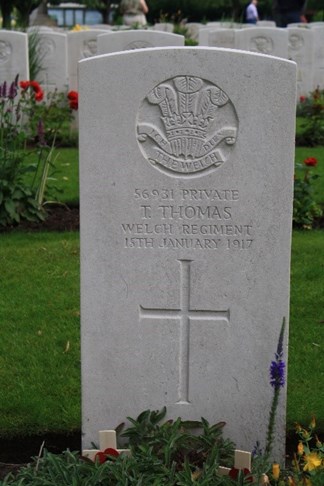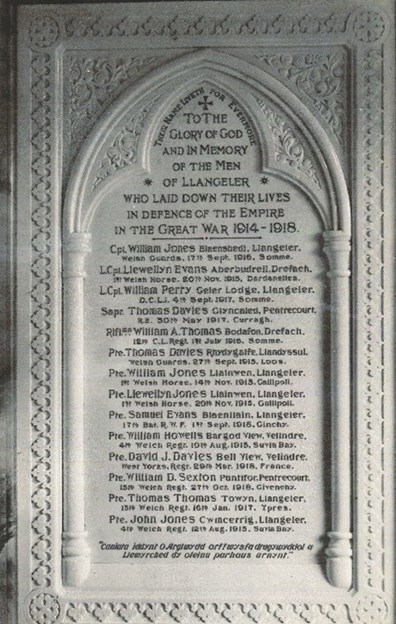Tom Thomas: a draper's assistant's war
- Home
- World War I Articles
- Tom Thomas: a draper's assistant's war
Thomas Thomas was the oldest child of Evan Thomas, a carpenter, and his wife Ann, a shopkeeper. Known as Tom, he was born on 15May 1891 in the parish of Llangeler, Carmarthenshire, and had two younger sisters – Elizabeth and Harriet. By the time of the 1911 census Tom had left the family home and was working as a draper’s assistant at David Evans – a fashionable department store in Swansea. Tom’s army records show that he attested in early 1916. His stated age in these records suggests a birthdate in June 1890, making him almost a year older than he actually was.

Above: Tom with his sisters, Elizabeth and Harriet circa 1914.
Tom was mobilised on 29 February 1916 and taken on strength in the Pembroke Yeomanry in March. Sailing from Southampton on 4 August, he disembarked at Rouen the following day. A week later he was attached to 13Battalion, Welsh Regiment, joining them in the field at Wormhout. This was shortly after the battalion had suffered heavy losses during the Welsh Regiment’s attack on Mametz Wood in July 1916.The battalion diary for 13 August states “…draft of other ranks Pembroke Yeomanry joined Battalion on this day”.

Above: Tom in 1916.
The following day the battalion moved into reserve lines at Poperinghe and Elverdinge, and the first weeks of Tom’s time in the Ypres sector were spent on working parties and training. From early September the battalion was regularly rotated between the front line and reserve trenches. The battalion diary for Christmas Day 1916 records “No work done except 1 party of 20 men for a short time during morning. All men had an excellent dinner…Turkey and plum pudding were provided by Welch Comfort Fund…A successful concert was held in the evening”.
On 13January 1917 the battalion moved up to the front line at Irish Farm trench sector, with the relief being completed by 10pm. There was heavy bombardment of the front line on the next day with many casualties. Tuesday 15 January also saw “...further bombardment of Irish Farm and Wilson Farm. Also right coys HQ …bombarded. Heavy casualties. Bn HQ moved to La Brique”. Tom was one of the unnamed fatalities on this day. Battalion diary records a quiet day on 16 January, but starkly states “Total casualties ascertained to be over 40”. It snowed all day on 17 January with the enemy quiet. Time was spent on salvage work and dugout construction, before the battalion was relieved in the evening.
The family’s griefin Towyn Cottage, Saron, on hearing of Tom’s death, may have been eased by letters received from one of his comrades. The first, undated, letter from L Charles Clark was received shortly after Tom’s death, saying that Tom had been hit by shell fragments whilst on gas sentry duty. His wounds were so severe “… that he was only conscious a few minutes”. The letter goes on to say how well thought of Tom was and that he “… couldn’t have died more bravely or manly than in the execution of his duty”.
A second letter followed in March from a hospital in Sheffield, where Charles Clark had been admitted after “successive bad colds”. This was in response to correspondence from Ann Thomas andprovides more information on Tom’s death, as it was not subject to the same censorship as a letter from the front. The shell that killed Tom had exploded right at the door of the dugout at which he was standing guard. Charles Clark goes on to give the location of Tom’s grave but regrets that a photograph would not be possible. “No one has cameras out there, barring aviators … the spy fever is too strong to do anything in the way of taking photos”.Charles Clark, although wounded in action, survived the war,being discharged from the army in October 1918.
Tom Thomas lies buried a short distance from Irish Farm trench, at Essex Farm Cemetery – the site of the Advanced Dressing Station where John McCrae wrote “In Flanders Field” in May 1915. The Grave Index of the cemetery [based on his army records] gives his age at death as 26 when he was, in fact, only 25.

Above: Tom’s grave at Essex Farm Cemetery in 2012.
Tom’s death was announced in the 26 January 1917 issue of The Carmarthen Journal – a weekly local paper. The same paper, in its 16 February issue, reported on a memorial service which the parents and sisters had attended. The parish church and other local chapels had cancelled their own services to allow their members to attend Tom’s memorial, and Saron Chapel was overflowing with people representing “every class and denomination in the parish”. The Welsh report ends with the sentiment – “All sympathise with the family after losing their dear boy, pure his path, who gave himself as a sacrifice for his country”. [Author’s translations]

Above: Welsh report of a memorial service for Tom – from The Carmarthen Journal of 16th Feb 1917 – from National Library of Wales Archives.
Tom Thomas is remembered on the family gravestone at Saron Chapel, and also on the parish memorial stone inside Llangeler Church. Tom’s sisters both lived full lives and died in old age. Harriet married a local farmer [my great uncle] but they had no children, whilst Elizabeth never married.

Above: Parish memorial inside Llangeler Church.
Article contributed by Arwel Davies
Acknowledgment.
I am grateful to the National Archives for access to Tom Thomas’s army record and the Battalion Diary of the 13 Battalion, Welsh Regiment. Thanks also to the National Library of Wales for digital access to historic issues of Welsh newspapers. These sources, together with family documents and photographs, have led to this article.





